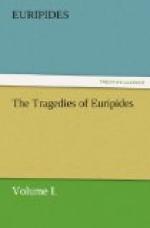[54] As one must make some translation, I have done my best with this passage, which is, however, utterly unintelligible in Dindorf’s text. A reference to his selection of notes will furnish some new readings, but, as a whole, quite unsatisfactory.
[55] Compare the parallel account in Nonnus, 46. p. 784.
[56] Alluded to by Oppian, Cyn. iv. 300. [Greek: apte selas phlogeron patroion, an d’ elelexon Daian, atarteron d’ opason tisin oka tyrannou]. He then relates that Pentheus was transformed into a bull, the Maenads into panthers, who tore him to pieces.
[57] [Greek: stochos] is either the aim itself, or the mark aimed at, as in this passage, and Xenoph. Ages. 1. 25.
[58] I have done my best with this extraordinary expression, of which Elmsley quotes another example from Archilochus Fragm. 36. Perhaps the notion of excessive rapidity is intended to be expressed.
[59] [Greek: ther] seems metaphorically said, as in AEsch. Eum. 47. Nonnus, 45. p. 784, 23. above, 922.
[60] Compare Nonnus, 46. p. 784.
[Greek: Kai tote min lipe lyssa noosphaleos Dionysou,] [Greek: kai proteras phrenas esche to deuteron: amphi de gaiei] [Greek: geitona potmon echon kenyren ephthenxato phonen.] * * * * * * [Greek: meter eme dysmeter apeneos iocheo lysses,] [Greek: thera pothen kaleeis me ton hyiea.]
The whole passage is very elegant, and even pathetic.
[61] Alluding to the horns of Bacchus. Cf. Sidon. Apoll. Burg. Pontii Leontii, vs. 26, “Caput ardua rumpunt Cornua, et indigenam jaculantur fulminis ignem.” See some whimsical reasons for this in Isidor. Origg viii. 2. Albricus de Deor. Nu. xix. But compare above, vs. 920. [Greek: Kai tauros hemin prosthen hegeisthai dokeis, kai soi kerate krati prospephykenai].
[62] Elmsley has rightly shown that [Greek: helika] could not of itself mean “a bull” or “heifer,” although Homer has [Greek: eilipodas helikas bous]. I have therefore followed Hermann, who remarks, “[Greek: helix] seems properly to be meant for the clusters of ivy with which the thyrsus was entwined. Hence Agave says that she adorns the thyrsus with a new-fashioned wreath, viz. the head of her son.” Such language is, however, more like the proverbial boldness of AEschylus, than the even style of our poet.
[63] “[Greek: korytha], ornamentum capitis, vix potest dubitari quin pro ipso capite posuerit.” HERMANN. There is considerable variation in the manner in which the following lines are disposed.
[64] Or, “Bacchus-mad.”
[65] I have marked a lacuna with Dindorf.
[66] See the commentators on Virg. AEn. i. 11. “Tantaene animis coelestibus irae?”
[67] After [Greek: tlemones phygai] supply [Greek: menousin]. ELMSLEY.
[68] A word is wanting to complete the verse.
[69] See Musgrave. Cranes are chiefly celebrated for parental affection.




